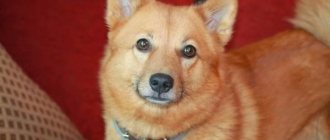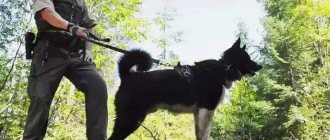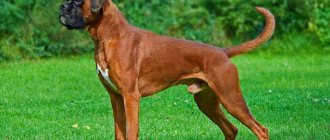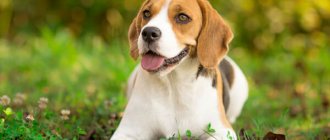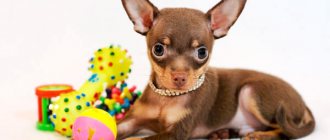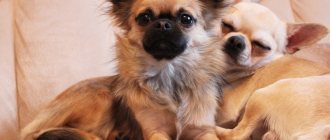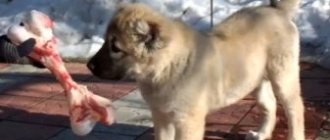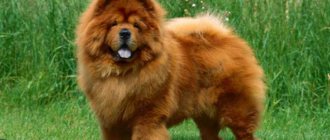History of the origin of the breed
Archaeologists claim that in ancient times the breed was widespread in the territory of modern Norway, Denmark, Finland and England. But the huskies of that time grew completely uncontrollably; according to all the rules of science, they began to be bred only in the 30s of the twentieth century.
- But the fate of the breed was not at all easy. The division between the USSR and Finland entailed the division of the breed.
- In Russia they began to breed the Russian European Laika, and in Finland - the Karelian Bear Dog.
- The wars, first Finnish and then World War II, severely battered the breed.
By mid-1945, there were no more than 50 representatives of this dog tribe, and they were sought by breeders in the most remote corners of the country, those least affected by the devastation.
In the same year, the English Club recognized the breed and the dogs received their official name and the opportunity to register pets according to approved standards. Over the course of a year, the number of the breed doubled and by the end of 1946 reached 100.
Today, about 800 Karelian Bear Dog puppies are born annually, and in Finland alone there are approximately 18,000 dogs today, so the breed has moved out of the rare category.
Description
KMS belongs to large breeds.
- The dog's height reaches 48 centimeters for girls and 58 centimeters for boys.
- Weight fluctuates around 20-23 kilograms.
- Life expectancy is 10-12 years.
As you can see in the photo of the Karelian bear dog, the animal’s fur is predominantly black, but the animal’s head, neck, paws, chest, and belly are beautiful white.
Some representatives of the breed have a brownish or matte tint. The dense and thick undercoat is covered by a completely straight and very thick coat of medium length.
Characteristic
According to the Finnish Laika standard, the dog is a hunting dog, mainly for small game, predators and some birds. By nature, the husky is passionate and independent; it can enthusiastically pursue prey for hours.
In Scandinavian countries - Norway, Finland, Switzerland - working qualities are tested for representatives of the breed. In the rest, they are limited to assessing the exterior.
FCI breed standard: No. 49
The Finnish Spitz is a dog of medium height and lean build, strong and muscular. The standard length of the body is equal to the height. The posture is proud, the movements are free - the transition from trot to gallop and back is natural. The dog is able to change the pace of movement sharply, accelerating and slowing down if necessary.
The energetic and courageous Karelian-Finnish Laika looks proportional. When viewed from above, her head resembles an oval, widening towards the ears. The ratio between the cranial and facial zones is 4:3. The lines of the muzzle and skull run parallel to each other. The frontal groove is weakly expressed, the stop is marked, but not protruding. The muzzle is narrow and dry, tapering noticeably toward the nose. The lobe is black, charcoal. The jaws and teeth, forming a scissor bite, are covered by thin but dense lips, brightly pigmented black. The dental formula is complete.
The cheekbones are weakly filled, only slightly pronounced. The eyes are almond-shaped, medium in size, set slantingly. The look is lively and attentive. The husky's ears are small, set vertically, high on the skull, directed forward. The shape of the ears is pointed, the thickness is medium.
The neck is muscular, without dewlap; in males it looks short due to the voluminous collar. The withers are clearly defined and flow into a short back with a muscular loin. The back ends with a medium-length croup, slightly sloping and well developed. On the rump there is a tail, curled into an energetic ring thrown over the back.
The sternum of the Finnish Husky is deep, with curved ribs, flowing into a tucked belly. The front legs are set parallel and straight, with strong shoulders and elastic wrists. Hindquarters - with wide hips and low hocks.
Disadvantages of the breed:
- weighted head, rough facial part;
- weak lower jaw;
- ears set at an angle;
- tail, undertwisted or twisted;
- sharp color transitions in color.
Serious defects leading to exclusion from breeding:
- soft rounded ear tips;
- broken tail;
- white “socks” on the paws or large spots on the chest;
- color in color, sharply different from the general shade;
- wavy coat;
- under/undershot;
- blue or amber eyes;
- nose of any color except black;
- aggression towards people.
Russian breeders distinguish the Karelian-Finnish variety from the Finnish Spitz by the following indicators:
- more stretched body;
- the shape of the head when viewed from above is triangular, not oval;
- flat skull;
- the stop is less pronounced;
- the ears are larger than those of the Finnish Spitz;
- the tail is curled into a tight ring, sometimes double;
- brown nose is acceptable;
- White spots in color are acceptable, fawn color is acceptable.
Best articles: Phanerozoic, or Phanerozoic eon (542 million years ago to the present)
Dimensions, weight and height of the breed
The height of the Karelian-Finnish husky is 47 cm for a male or 42 cm for a female. Deviations in both directions of 3 cm are allowed.
Ideal weight for the breed:
- 12-13 kg – males;
- 7-10 kg – females.
Possible colors
The Finnish husky's coat is of moderate length and lags behind the body due to the abundant undercoat. On the head and limbs it is shorter and fits more tightly to the skin. The guard hair is coarse, the undercoat is soft and downy.
Color – red. At the same time, the fur on the back is bright, golden-red, and on the ears, throat, sternum and belly it is lighter. A white mark on the chest is allowed.
Puppy weight by month
Karelo-Finnish huskies vary in size. One litter can contain puppies of different parameters. Each individual’s development is individual, but breeders offer tables of average puppy measurements for reference.
Weight-for-age ratios:
- 1 month – 1.2 kg;
- 4 months – 3.1 kg;
- 6 months – 5.1 kg;
- 8 months – 7.5 kg;
- 10 months – 10 kg;
- 12 months – 11 kg.
Lifespan
Finnish huskies are hardy dogs that can live up to 15 years with good care. Take your dog for a veterinary examination every year, feed it according to the diet and walk it according to the schedule. A grateful pet will delight you with excellent health until old age.
Allergenicity
The Karelian-Finnish husky does not emit a “dog” smell, but its fur, skin or sebaceous secretions can cause allergies. Before purchasing a Laika, check your body’s reaction to allergens and visit the Karelian breeder, asking to arrange close contact with the dogs for the whole day. If there is no reaction, feel free to buy a puppy.
Relationships with people
The Karelian Bear Dog chooses one single owner to whom it will obey. Usually this is a person who can break the pet’s willfulness and show a stronger character. The dog will treat all other family members with respect and love, but will not follow their orders.
- The dog gets along well with existing children and will play with them, especially in outdoor games, but it is necessary to take into account the size of the pet.
- Having played out, he can demolish the baby without even wanting it.
- An obstinate dog will not take the appearance of a new child very well; the dog’s jealousy can manifest itself in the most unexpected way. Although it will not harm the baby.
KMS is very sensitive to his territory and will become a wonderful guard, but he will not make a good watchman. She will let the owner detain the intruder, calling him with a loud bark.
A dog can bite a person only in very extreme situations. Although, at the slightest threat to the life and health of any family member, the dog will bravely rush into battle, regardless of the size of the enemy. It was this quality that once almost destroyed the Finnish Laika breed.
The dog is extremely wary of strangers. And he will be just as wary of people who come too close to their loved ones.
Life expectancy and major diseases
A Karelian dog in normal conditions, with good physical activity, can live up to 15 years, sometimes more. It tolerates seasonal temperature fluctuations well. Just don’t keep it in direct sunlight for a long time to avoid overheating.
Possessing naturally good immunity, she practically does not get sick, except that in old age she may begin to have problems with the musculoskeletal system, the gastrointestinal tract, allergies may develop, and eye diseases may arise. Here, at the first symptoms, the help of a veterinarian is necessary.
Relationships with other animals
Finnish huskies will also defend their territory from other representatives of the animal world. They will be very aggressive towards other dogs, even if they are brought by their beloved owner.
And because of their strength and courage, they will come out of almost any fight with honor, forcing the enemy to look for another shelter.
- At the same time, the Karelian is not a fighting dog at all; he will not fight with the alien to the last drop of blood if he leaves the protected area in time.
- But when hunting, the dog can tirelessly pursue prey and detain it until the main forces arrive.
- Karelian Bear Dog puppies can make friends with other animals if they are all raised together, and the Karelian newcomer is included in an already established team.
Dogs will not touch sheep, cows and other large animals, but cats and rabbits may well be considered their rightful prey. If a canine child is raised correctly from early childhood, he will be calm towards poultry.
Appearance of the Karelian-Finnish Laika
The Karelo-Finnish Laika is a medium-sized hunting breed, with fluffy “honey” fur and brown or black eyes. The dog has a dry, strong type of constitution, almost square in format. “Boys” are on average slightly larger and more massive than “girls.” The breed standard defines the following parameters: height at the withers – 42-50 cm (for males) and 38-46 cm (for females); body weight – 12-13 kg and 7-10 kg, respectively.
Head
The Karelian skull looks oval on top and slightly convex on the sides. The brow and occipital protuberance are not very pronounced, as is the frontal groove. The feet of representatives of this breed are clearly drawn, but not too sharply. The muzzle is narrow, with a flat back, and dry.
Jaws and teeth
The dog's jaws are massive, closed in a tight scissor bite. The teeth are strong, even, symmetrically set.
Eyes
Karelian-Finnish huskies have not very large, almond-shaped eyes, set somewhat obliquely. The iris of the eye is dark colored.
Ears
Ears are set high and erect. The ear flap is small, pointed in shape, the outer side is hidden under a layer of thick short hair.
Neck
The neck of the Karelian-Finnish Laika is of normal length, but due to the voluminous woolen “collar” it gives the impression of being short and thick.
Frame
The correct “Karelo-Finn” has a strong physique. The body of the dog is square in shape with a straight back, a massive, sloping croup and well-defined withers. The stomach is slightly tucked.
The legs of the Karelian-Finnish Laika are straight, set parallel to each other. The front legs are characterized by well-developed bones, mobile, slightly inclined shoulder blades and normal length pasterns. The hind legs of this breed are strong, with fleshy thighs, muscular shins and low set hocks. The dog's paws are round, almost cat-like, with the front ones slightly shorter than the back ones.
Tail
The length of the tail of the Karelian-Finnish husky is up to the hock joint. The section of the tail bordering the base is turned sharply towards the back, which is why the rest of it rushes down and hangs down to the hip.
Wool
On the head and the front of all four limbs the hair is relatively short. On the body, tail and hips the coat is longer, more luxuriant, noticeably lagging behind the body. The guard hair on the shoulder blades of male dogs is especially noticeable - it is hard and stands almost straight up.
Color
The backs of Karelian-Finnish huskies are more intensely colored and come in rich red or reddish-golden tones. The dog's cheekbones, insides of the ears, legs and tail, as well as the chest and underbelly are noticeably lighter. The presence of white spots on the paws and a light mark on the chest is considered normal.
Disadvantages and defects of the breed
The most typical defects of Karelian-Finnish huskies are a large head, a heavy muzzle, an underdeveloped lower jaw, and an excessively or insufficiently curled tail. Often among Karelians one can find such deviations from the standard as sharp transitions between shades of color, ears hanging to the sides, ears tilted back or tips directed towards each other, as well as soft pasterns. If we talk about disqualifying defects of the breed, then these include:
- blue and yellow colors of the iris;
- the tips of the ears are too soft;
- any deviations from the standard bite;
- wool with a wave or pronounced curl;
- large white markings on the chest and the same “socks” on the animal’s legs;
- depigmented lobe;
- unjustified aggression directed at a person.
Character
All reviews about the Karelian Bear Dog note the responsibility and determination of the breed, especially in “working conditions”.
Everything else depends on training. There is no need to buy such a fluffy life partner for weak-willed people, children or those who like to lie on the couch.
Content
The Karelian Bear Dog is an active member of the family. She certainly needs physical and mental stress, space and the opportunity to warm up at any time. Therefore, she will become an excellent companion for people with a sports lifestyle, accompanying them on endless runs.
At the same time, it is important for the dog to run around without a leash for at least some time, straining all his strength and muscles.
- The best option for keeping him would be his own house with a plot, and the dog can live in a spacious enclosure.
- There is no need to worry about your dog being cold in winter.
- The ancient breed adapts perfectly to any weather conditions.
Reviews of the Karelian Bear Dog mention the constant desire of the black and white pet to bark. She will happily bark at passers-by, birds, cars, so city residents will not be very happy about such a neighborhood.
How to name
When choosing a nickname for your pet, do not forget that not only the owner, but also the dog should like it. It is desirable that the nickname be short, easy to remember and sonorous.
- For example, the following nicknames may be suitable for boys: Archie, Thunder, Baron, Stark, Stiff, Vegas, Ryder, Onyx.
- Girls may like nicknames: Jessie, Dolly, Alba, Goldie, Gretta, Sanda, Assol.
Note! When naming your pet, it is worth remembering that this nickname will have to be pronounced a huge number of times a day.
Therefore, it must be associated with something good that evokes positive emotions. It could be a beautiful vacation spot, an exotic drink, or the name of a flower, dance, or area.
Care
The dog will not require much care. Like all real hunters, she is quite undemanding in terms of living conditions. The only thing that is required from the owner, in addition to a sleeping mat, is weekly combing of the pet’s thick skin. And during the molting period, wool will lie everywhere.
- The dog is also calm about its diet: it will happily eat both ready-made food and natural food.
- Half of the diet should be meat, preferably beef and chicken, sometimes you can treat your pet to fish.
- The remaining 50% comes from cereals, vegetables, and bran.
- Karelian Bear Dog puppies additionally receive vitamin supplements with calcium.
- An adult dog is fed twice a day, children are fed 3-4 times.
Mating
If the dog has a good exterior and has documents confirming its pedigree, which gives permission for breeding, then you can think about mating. Do not also forget that an untied male must have at least 2-3 matings per year. If the owners do not intend to do this, there is no point in starting.
Attention! Suitable for mating are females aged 2 years and older, males aged 1.5 years and older.
A virgin male, having found no use for his sexual instincts, will gradually calm down and stop paying attention to the opposite sex. After all, in the wild, not all males are worthy of procreation, but only a select few.
The same applies to bitches. If the girl is of outstanding blood, whose puppies are in great demand, she can be bred. And if no one needs growing kids, you shouldn’t have them, so as not to rack your brains about where to place them.
Once a bitch has gone through motherhood, she will continue to prepare herself for a meeting with a male dog, and if she does not get what she wants, she will experience a psychological breakdown. So before breeding a pet for the first time, you should think about the future life of your beloved animals.
Kids waiting
Training
Like all hunting dogs, the Karelian Bear is distinguished by stubbornness and independence from birth. To raise a fully socialized dog, it is better to seek the help of a professional dog handler.
If this is not possible, then you will have to communicate with the dog quite strictly, but without the use of physical violence or rudeness.
The Karelian Bear Dog will be a good friend and reliable protector of its entire human “pack,” but it will never become a domestic play dog.
Vaccinations
Vaccination is the most reliable means of protecting a dog from viral diseases. A puppy separated from its mother loses antibodies that enter the body with mother's milk. This is where the vaccine comes to the rescue.
The first vaccination begins from 8 weeks of age until one year. Before vaccination, the puppy is wormed and fleas are removed. At the time of vaccination, the dog must be completely healthy.
Attention! The gap between the first vaccination and the next one should be 3 weeks. Before starting contact with other dogs, after the second vaccination you must undergo a ten-day quarantine.
This is the period when the body develops immunity to diseases. At this time, the animal’s immunity weakens; veterinarians do not even recommend bathing the dog.
Healthy baby waiting for vaccination


